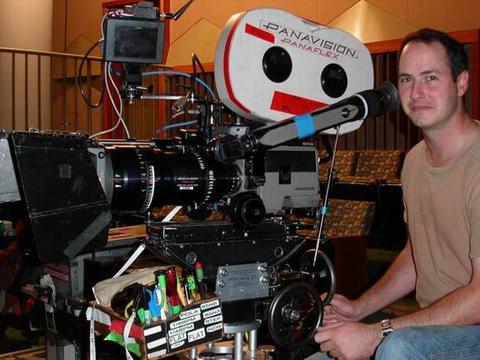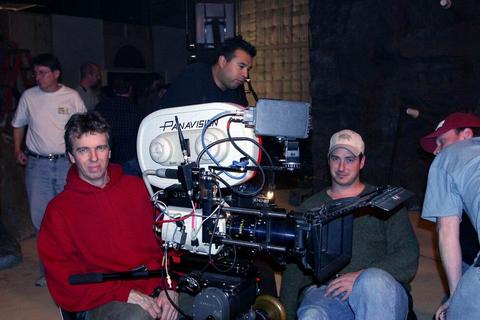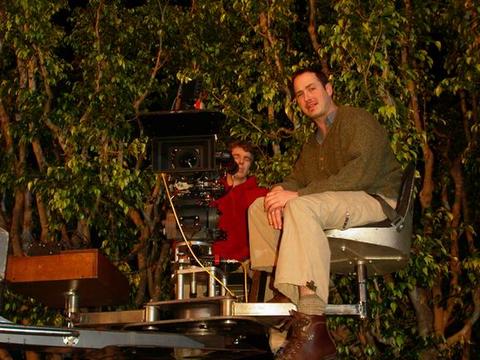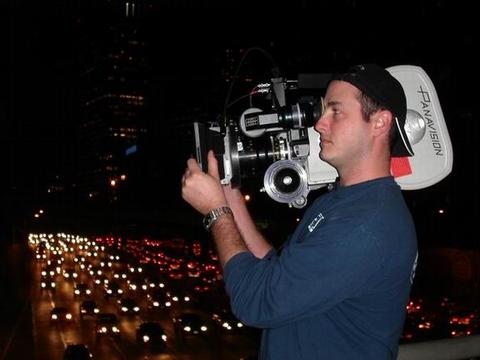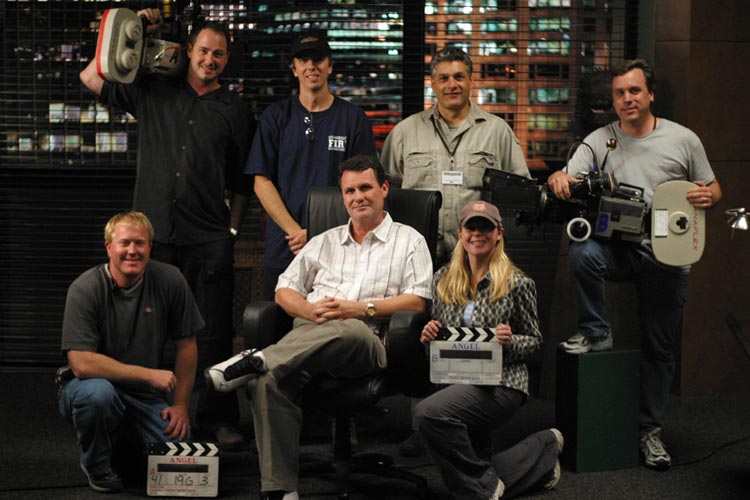|
Homepage > Joss Whedon’s Tv Series > Angel > Interviews > Adam Ward (angel camera assistant) - COA.com Interview
From Cityofangel.com AngelAdam Ward (angel camera assistant) - COA.com InterviewBy Tara DiLullo Thursday 11 December 2003, by Webmaster Through the Lens An Exclusive Interview with Adam Ward From the moment Angel hit the airwaves back in 1999, the audience immediately knew the look of this show was as distinct as the premise. The normally sunny landscape of Los Angeles was transformed into a noir wonderland where the action happens almost exclusively under the cloak of night, creating a world of rich atmospheres and heightened mystery. Shot in the widescreen format since the third season, the cinematic qualities of Angel have only heightened under the guidance of the show’s esteemed director of photography, Ross Berryman. Having learned what it takes to light Angel with Chief Lighting Technician, Dan Kerns earlier this year, CityofAngel is now shedding light on the other piece of the visual puzzle, the camera department. Berryman has assembled an impressive crew of talented camera people who focus their lens on this strange world weekly. Luckily, Adam Ward, the ’A’ camera first assistant/focus puller for three seasons, graciously gave us a rare look at their world of light and shadows THE MIX OF LIGHT AND LENS To achieve the "look" of Angel, lighting and camera departments work under the guidance of Ross Berryman, the DP, to capture on film the framing, lighting and overall composition requested by the episode director. The camera department on Angel is comprised of a first unit team, which operates the main ’A’ and ’B’ cameras that work daily to film the principal photography of the show. The second unit team primarily works on scenery, crowd or pick-up shots to be used as fill or transition moments in the particular episode. As with all departments in the production crew, Adam explains there is a hierarchy for his team. "You have a camera intern, a loader position, the second assistant cameraman (which a lot of times is the loader, as well, on small shows) and the first assistant cameraman, which is what I am, a.k.a. the focus puller." In other words, all those jobs you read in the credits but have no clue what they do. Let us explain: Camera Operators - are the people who operate the actual camera per the instructions of the director of photography. Assistant Cameraman - is the assistant to the camera operator. This person is responsible for the maintenance and care of the camera and may also perform the duties of a focus puller. Focus puller - is the person who manually adjusts the focus of the camera during filming to make sure the subjects are always in focus during each shot. Camera loader - is the person who operates the clapboard at the beginning of a shot and loads the film stock in the cameras. The clapper title used to the refer to the older clap boards, which actually clapped to synch audio and video before the scene was shot in the pre-digital days. Adam’s position on the crew is one he truly loves. "These aren’t auto focus cameras [we use], which a lot of people aren’t aware of. [My job] is such a challenge on our show because it’s about the nature of physics. It all relies back on the depth of field in the lens and how much available light is actually on a set. The lower the light; the lower the depth of field. Forty years ago, focus pullers wouldn’t have to worry about that because the fastest lenses out there were 5/6’s and 8’s (re: the F-stop). "As a broke college kid, I said, ’How do you like your coffee?’" Adam on getting into the camera department. Nowadays, everything has gotten faster, lighter and brighter. We have to be on top of our game, especially on a night show but it’s a place where I am happy to be." Adam came to his position on Angel in an admittedly indirect manner. "It was a weird mish-mash of trails that got me here. I was in the military for five years right out of high school - in the NAVY Special Forces. Being a SEAL, I didn’t see many movies and had no idea that this position existed. When I got out of the Gulf War, I left the Navy to go back to school and my ambition was to get my engineering degree and go back in the Navy as an officer." "While I was in school at the University of Florida, I got sidetracked. A buddy of mine was a PA (production assistant) on a show and he said they always needed PA’s for $150 a day. As a broke college kid, I said, ’How do you like your coffee?’ he laughs. "I got onto that show and into the camera department as an intern. That led to a loader position and a second AC position. I got onto a show called, SeaQuest D.S.V, where I got my union ranks and then I came out to L.A. in 1996." "I got into the local union out here and started on Cybil," he continues. "Then I did a bunch of features like Collateral Damage, Baby Boy and Training Day. I met up with Ross in 2000 and we hit it off fabulously. He had just got back from doing four years of Early Edition in Chicago and that was all she wrote. I’ve given up working for anyone else and I’ll spend the rest of my career working for Ross Berryman. He has been a DP for forty years so its nice to work with someone who cares so much about what he does. He just got ASC (American Society of Cinematographers) status and Ross is so humble about it. He just loves what he does and could care less about the awards. He was ACS (Australian Society of Cinematographers) long before he came to the U.S. It’s akin to a Ph.D. at the end of your name and he has two of them for two different countries," Adam enthuses. Being on Ross’s team for years means Adam has risen to a level where he not only works with the rest of the camera team but he sometimes brings new people into the fold. "I do the hiring of the assistants. Ross gives me the liberty to do that and while he has overall say, he trusts me." Adam is enthusiastic in describing the current crew. "Ross has two brilliant operators, Tony Politis, who is the ’B’ Camera Operator. He used to do The Crocodile Hunter shows for Steve Irwin. Joe Broderick is an incredible ’A’ Camera Operator and Steadicam Operator. He is phenomenal at designing and framing shots. I’m very honored to work with them." "The ’B’ Camera Focus Puller is David Dowell, who is incredible with long lenses. The ’A’ Camera Second Assistant is Carter Smith. I’ve known him since he was a loader and I promoted him last season to ’A’ camera. He came on the show as a loader the first season. He is in charge of every single nut and bolt in the camera department. He orders all the equipment. The ’B’ Camera Second Assistant/Loader is Britta Richardson. I met her and Tony on a show in San Diego called, Cover Me. She has the plucky spirit of the crew. She has to keep up with all the film, all the footage that goes through every single camera, ordering stock and loading all the cameras, as well as, double teaming as the second assistant." THE ANGEL LOOK As the series has progressed, the overall look of the show has gotten richer and more seeped in the noir look reminiscent of the hardboiled, detective era films of the forties. "Ross likes a classic, three quarter lighting," Adam details. "He likes to underexpose or shadow the side of someone’s face, which has the noir look he has been going for." Another key factor in the overall look is the letterboxed format in which they now frame and shoot the series. "We changed up on the third episode of the third season. They had to go back before they aired the first two episodes and re-transfer the other footage to the wider format. We generally tried to frame for it anyway to be safe so they were able to transfer to the 16x9 letterboxing easily. We were really happy to do it because it made everything a lot more cinematic." This season, there is a new centerpiece set. The Wolfram & Hart offices allow for the introduction of more daylight on the show but it hasn’t changed Berryman’s overall approach. "The new Wolfram & Hart set has given us more flexibility and movement of the cameras. We have a bigger set so we can do a lot of dolly shots, 360’s and tandem shots with the A & B cameras together. But Ross still likes to work at a lower light level to give a different look for the show. We operate at a 2.8 aperture, which is at the bottom of most lenses. It’s pretty much the staple for the show to be dark, moody, with edgy lighting, which is his signature." "Sometimes our Friday nights are long. We’ll shoot night exteriors all night and see the sun come up." Adam Another change for the camera department has been the advances in technology for a very effects-heavy series. "A lot of times we stymied by the constraints by effects shots," Adam explains. "Four years ago, when we had effects shots like dusting, we had to lock off the camera and get height, angle, distance, and inclination of the camera measurements. But thanks to the innovative genius of the special effects houses, they have been able to progress past those limitations so we can move the cameras now. We use memory heads, which hold the camera in position and we can recreate the entire move of a camera identically. Instead of static frames when there is a morph or a dusting, we are now able to move the camera in such a way that keeps the motion of the show. Ross is always trying to keep the camera moving, even if it’s a small creep." But by far, the biggest challenge for the crew all season is the brutal pace in which they churn out episodes. Every eight days, production starts on a new episode, which means translating roughly fifty plus pages of script, with multiple locations, set-ups, special effects shots and run of the mill crises, into the necessary shots needed to make a complete episode. "One-hour episodics are, pardon the expression, just a shit fight to get done on such a tight schedule," Adam laughs. "We have to buckle down and work like a tight knit team to get things done. It’s daunting at times but it’s amazing how much we turn out in a day. A lot of times, we’ll have an eight or nine-page day. On a feature film, they are going to do maybe one or two pages a day. We accomplish a lot in a short time." "But then it’s kind of a catch 22," he continues. "We do better on the Wolfram & Hart sets because we are in a controlled environment. The problem then is that we may do a nine page day and then the producers know that we can accomplish that so we’ve kind of bit ourselves on the tail by doing such. It becomes a norm so then your game steps every time you are on a set location, so it’s exponential as far as our progressive levels." Despite the pressure, Adam says the Angel set is wonderful in comparison to others. "Our hours are pretty decent because our producer, Kelly Manners is such a crew-oriented producer. He likes to keep the workday at twelve hours and give us a life unlike other shows that have fourteen plus hour days. Sometimes our Friday nights are long. We’ll shoot night exteriors all night and see the sun come up. But it’s such a bear to break into this industry as an outsider because the unions make it difficult to get into the training programs. So we realize that when we are tired in the eleventh hour, we are shooting TV or a movie and we are lucky and really enjoy what we do. It makes twelve hours go by like an eight-hour day. We wouldn’t be half as far along as we are if we didn’t have such a great cast David, Amy, J. August and Alexis are beautiful people...even though David is a Philadelphia fan," Adam laughs. "You get a lot of prima donnas in Hollywood and we are fortunate to not have any on our show. Plus, we have a couple great additions to our cast. James Marsters (Spike) is fantastic. It’s always unnerving when you get a new cast member because you don’t know what to expect but he is just the most down to earth, humble guy and everybody appreciates that." CALLING THE SHOTS An interesting element the camera department must deal with each and every episode is adapting their skills to the needs of the individual directors. "Each director has a different vision," he details. "Some are very green and new and they don’t know how to get what they want visually so Ross is always there to co-direct for them. They are always smart enough to listen to the wisdom of Ross and get their vision across and we are always there to help them." Speaking of which, a new director debuts on the tenth episode this season (airing January 21st, 2004) and he has a very familiar face, actor David Boreanaz. "David did a phenomenal job," Adam raves. "He was also down with reconstructive surgery on his ACL on his left knee during his entire directing debut. Imagine the task of that, directing and acting! Kudos to David because he came through with flying colors and did a great job. He didn’t have the cinematographer’s vernacular but he could convey his feelings to Ross very well and that is paramount in TV directing. He did very well." A definite perk for the team each season is the chance to work with creator, Joss Whedon on an episode. "It’s always fun to have Joss around and he is around quite often whether he is directing or not. He does know exactly what he wants and he does know technically how to achieve the shot and he is versed in everything - The Wonder Boy," he laughs. "He knows everyone by first name and it’s great to be around a person who can convey the vision that he does." Joss has also made a point to allow his writers the chance to bring their words to visual life, which means the camera crew gets to work closely with the people behind the pens - a rare occurrence in television. "We are fortunate to have brilliant writers on the show that periodically get to come down and direct and its gives them a real idea of what the limitations of their vision are - whether they have to scale it down a bit or sometimes they are happy to get more than they expected. It’s nice to get fresh, new breath that comes in with the happy zeal of a schoolboy excited to see their vision created. I think it’s a smart thing the producers have allowed this because you don’t get the same pigeonholed aspects of twenty-year directors. With new people coming in, it’s fun to get their vision on film. "It’s never the same what we do from one episode to the next so there is no monotony, Adam continues. "You don’t know what you are going to do until you get the script. Jeff Bell’s "The Cautionary Tale of Numero Cinco" was a fun one to do and Ross really enjoyed it. It was very difficult because we has an entire cemetery scene, which we shot over at Hollywood Forever Cemetery, that we had to shoot in all these different directions and then turn cameras and re-dress." Episode eight, "Destiny" also gave the crew another major unexpected challenge in the form of the abandoned Opera House. "That was a hell of a thing "It’s one thing to see it on camera and another being on location in this theater that hasn’t been used other than for film shots for decades. You get in there and the matter that floats around looks great on camera but you just don’t want to breath it in," he chuckles. Season five has already provided a plethora of visual delights for fans and the camera crew achieving them. As for Adam, he shares, "This season, I really liked Steve DeKnight’s, "Hell Bound." I really liked the style of that show and I’m a horror fan from a young age. It was a very difficult challenge for me as focus because everything was wide open. I had no depth of field because it was very dark with tight lenses. I got to use my infrared laser focus unit that I had patented last year. It’s called "The Sniper" and it’s a laser that I match on the camera in tandem with the lens and it gives me constant readings of whatever the camera is pointing at with an accuracy of a quarter of an inch. It helped out tremendously because we were doing some crazy stuff that would have been impossible anywhere else." With long hours spent together during the week, Adam reveals the crew hangs out together after work too. "We’ve got a tight knit family on the film set. This season we had the Angel softball team that bats Saturdays and Sundays against the other primetime networks. We also do a lot of golfing." "The weekends are ours and we cherish them," he continues. "I do anything I can to get out and clear my head and try to not think about the dailies coming in on Monday." As for the end of the season, Adam says rest is relative for the crew as well. "Our hiatus at the end of the season lasts about two and a half months and most of us do other projects during the summer hiatus because we are so wound up to work. Sitting on your butt for two weeks, you get cabin fever," he laughs. "We try to center projects around that time like a ten-week feature or day work to fill in time but some of us take a month off and that’s nice too." With only half the season complete, Adam and the crew have a long time before they can drink those cocktails by the pool, but there’s no doubt shooting Angel is where they’d rather be.
|
